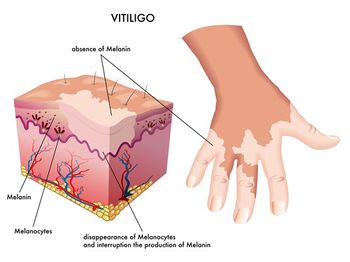Vitiligo
Vitiligo is a condition that causes depigmentation of sections of skin. It occurs when melanocytes, the cells responsible for skin pigmentation, die or are unable to function. The cause of vitiligo is unknown, but research suggests that it may arise from autoimmune, genetic, oxidative stress, neural, or viral causes. The incidence worldwide is less than 1% The most common form is non-segmental vitiligo, which tends to appear in symmetric patches, sometimes over large areas of the body.
Symptoms
The most notable symptom of vitiligo is depigmentation of patches of skin that occurs on the extremities. Although patches are initially small, they often enlarge and change shape. When skin lesions occur, they are most prominent on the face, hands and wrists. Depigmentation is particularly noticeable around body orifices, such as the mouth, eyes, nostrils, genitalia and umbilicus. Some lesions have hyperpigmentation around the edges. Patients who are stigmatised for their condition may experience depression and similar mood disorders.
Home remedies
- Folic Acid, otherwise named vitamin B9, along with other B vitamins may be a natural way to introduce new pigment to areas of skin that are affected by vitiligo. A study reported in the July 1992 issue of the journal "Custis" explains that people who have vitiligo often display lower-than-normal levels of folic acid and vitamin B12 in their blood. Further studies reported by the NVF suggested that supplementing the diet with 10 mg of folic acid and 2000 mcg of vitamin B12 each day may lead to select repigmentation in some people. Folic acid and other B vitamin supplementation is generally required for at least three to six months in order to see results.
- Ginkgo Biloba : Alternative medicine experts at the Mayo Clinic suggest that there may be a link between gingko biloba and skin pigment. The clinic studied people whose vitiligo spread slowly, and gave one group 120 mg of the natural herb each day. Some of the patients who received the supplements noticed areas of repigmentation as a result of using the supplement. People who are interested in trying gingko biloba as a natural vitiligo treatment should do so only under the supervision of their doctors.
- Vitamin C : Dr. Leopoldo Montes, author of the book "Vitiligo: Nutritional Therapy," states that vitamin C levels tend to be low in people suffering from vitiligo. Adding more ascorbic acid to the diet through food sources or vitamin supplementation may be another natural approach to treating the lack of pigmentation caused by vitiligo.
- It is interesting to note that as early as the 1980's, medical researchers had reported that they cured people of vitiligo using herbal extracts, mega doses of vitamins or a combination of herbs and vitamins.
- Light Therapy
- Sun Exposure : Exposure to natural sunlight, rather than lab-created UV rays, may help vitiligo patients gain some new pigmentation. Light therapy is more likely to be successful when used in conjunction with a regimen of vitamins B and C.
- Picrorhiza : Taking picrorhiza by mouth for up to one year, in combination with a conventional medication called methoxsalen, seems to help treat vitiligo in adults and children.
- Khella has been used for treating vitiligo. The khellin component of Khella together with sun exposure gives 76-to-86 percent effectiveness. (See warnings Khella)
- Some people apply Bishop's Weed directly to the skin for skin conditions including psoriasis and vitiligo : Bishop's weed contains several chemicals, including methoxsalen(Oxsoralen, Methoxypsoralen), a chemical used to make a prescription medication for the skin condition psoriasis.
Medical Disclaimer
This information is not meant to be substituted for medical advice. Always consult a medical professional regarding any medical problems and before undertaking any treatment or dietary changes.
